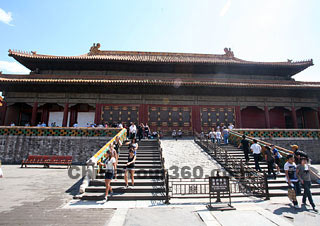 |
| Palace of Earthly Tranquility, Forbidden City |
The Palace of Earthly Tranquility (Kunninggong) is the last of the three palaces in the Inner Court of the Forbidden City. Originally built in 1420, it was destroyed by fires twice, in 1514 and again in 1596. It was repaired in 1605. During the Qing Dynasty (1644 - 1911), it was rebuilt in 1645 and in 1655. Among three palaces, the Palace of Heavenly Purity (Qianqinggong) represents masculinity and the Palace of Earthly Tranquility signifies femininity. The two palaces together symbolize the harmony and unity of heaven and earth.
During the Ming Dynasty (1368 - 1644), the Palace of Earthly Tranquility was a chamber for the empress. It had nine rooms in total, with a warmth chamber on the east side as well as the west. Throughout the reconstruction of the Qing Dynasty, its original Ming Dynasty architectural style was changed according to the customs of the Manchu people. Except for the eastern warmth chamber, the other parts were all re-designed as a place for offering rites to Shamanist deities.
In the Qing Dynasty, the eastern warmth chamber was made into a bridal chamber for the emperor. According to the historical records, four emperors held their wedding ceremonies here, including Emperor Puyi, the last emperor of the Qing Dynasty. Today, the eastern warmth chamber remains the same as it was during the wedding of Emperor Guangxu. The inner walls are painted red, and palace lanterns with the Chinese characters "Shuangxi" (Double Happiness) hang from the ceiling. Both sides of the screen inside the west door and the screen outside the east door are decorated with golden Chinese characters "Shuangxi” (Double Happiness), which means finding happiness once exiting the door. A dragon-phoenix bed is set up at the northwestern corner of the chamber, covered by a ‘Baizi Bei’ (a-hundred-children quilt) and hung round with ‘Baizi Zhang’ (a-hundred-children canopy). Although it was the bridal chamber, the emperor and empress would only spent two days here. They would move back to their usual chambers on the third day after the wedding. Of course, if an emperor was married before ascending to the throne, he would not have the chance to enjoy such a special treatment here.
The Manchu people always paid much respect to the deities, so offering rites to the deities was very important to them. Every year, the royal family held many sacrifices. The four rooms in the west of the Palace of Earthly Tranquility were converted into places for sacrifices. A four-leaved door was opened in the third room from the east. Opposite the door in the room were three cooking pots for boiling meat to offer to the deities. On every first day and 15th day of a month, the emperor and the empress offered rites to the deities here in person. When there was a big ceremony or on New Year’s Day, the empress would hold celebration rites here.
Gradually, Palace of Earthly Tranquility became a sacred place dedicated to sacrificial ceremonies. In other words, there were only a few empresses who have lived in the palace during the Qing Dynasty.
![]() Go to the Next Attraction: Imperial Garden
Go to the Next Attraction: Imperial Garden








